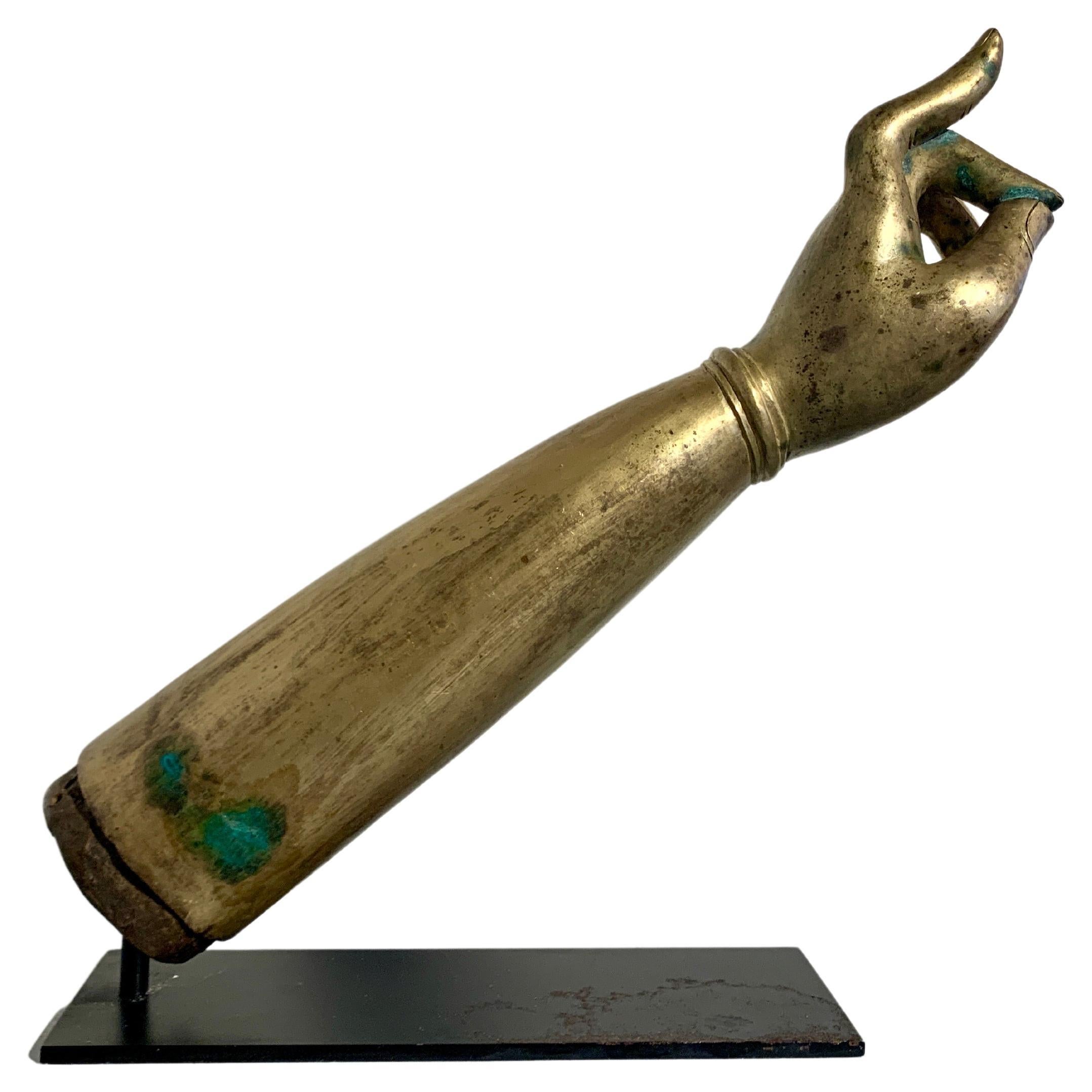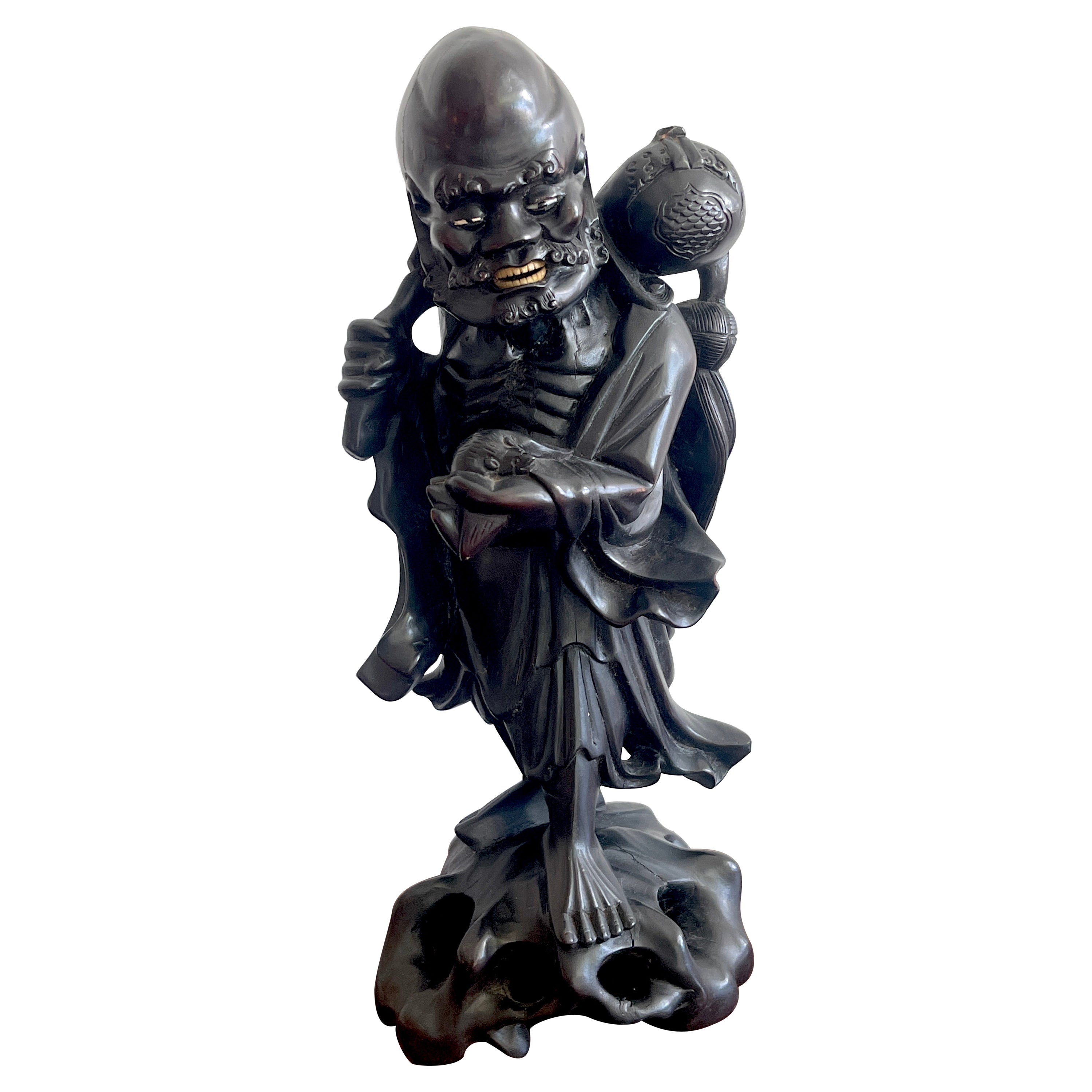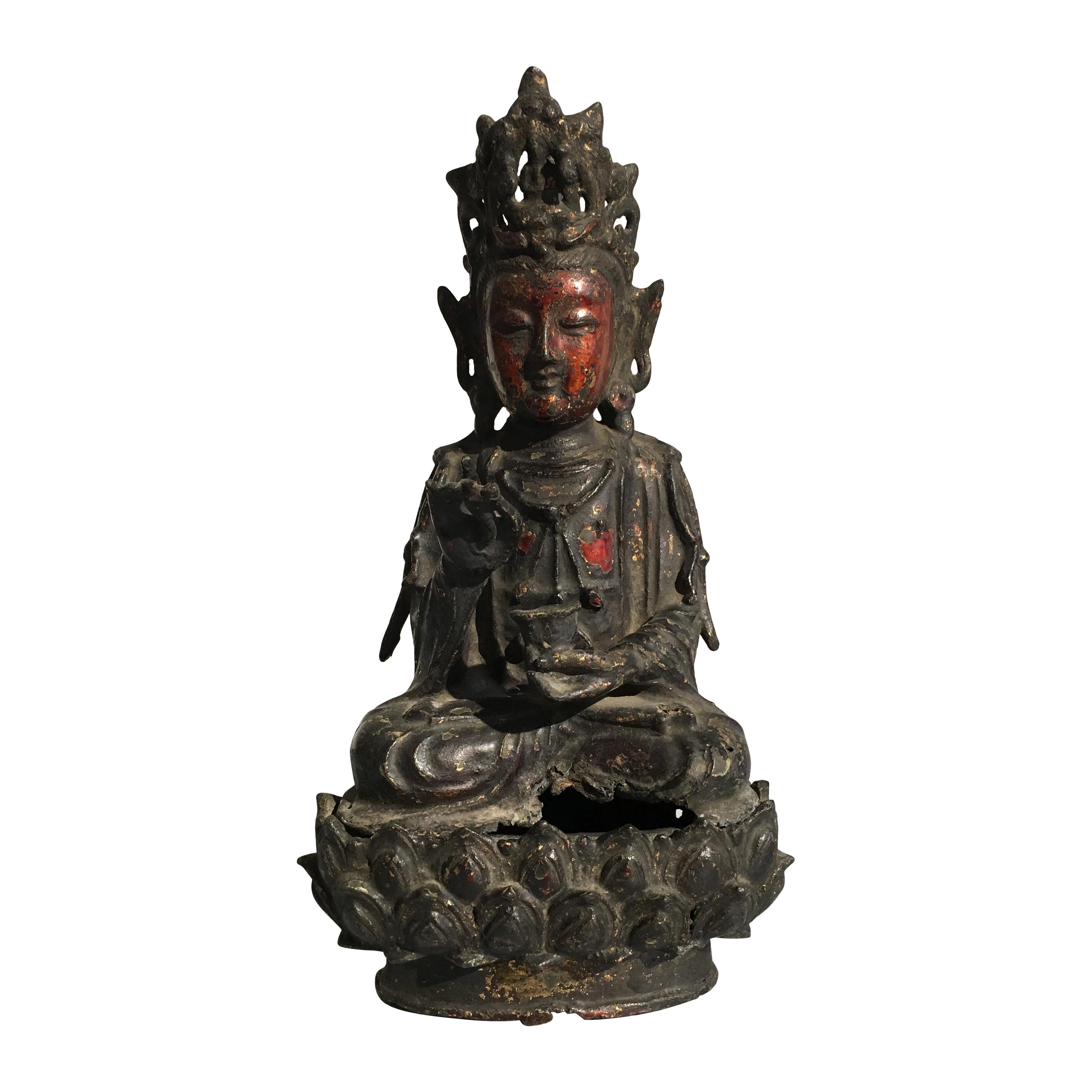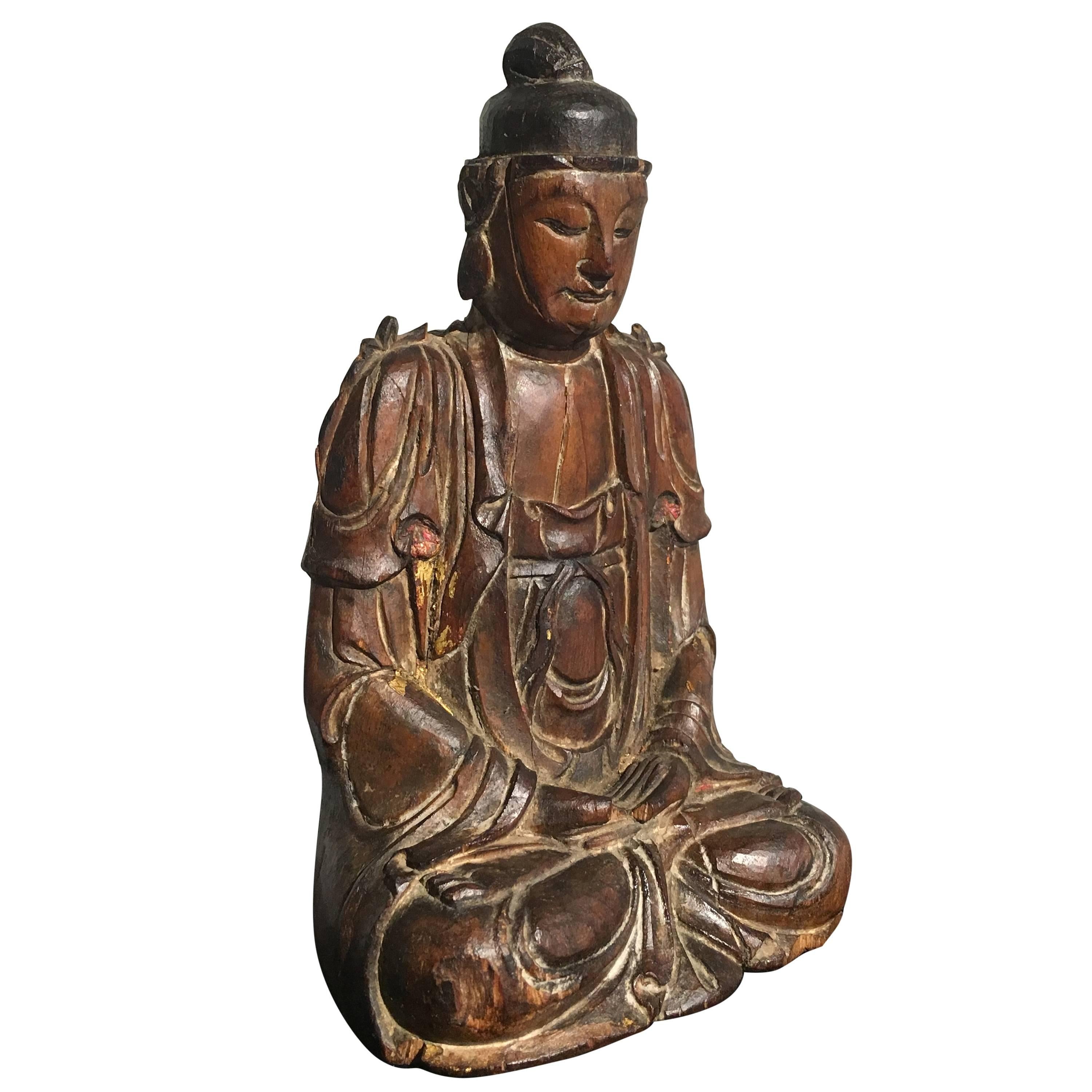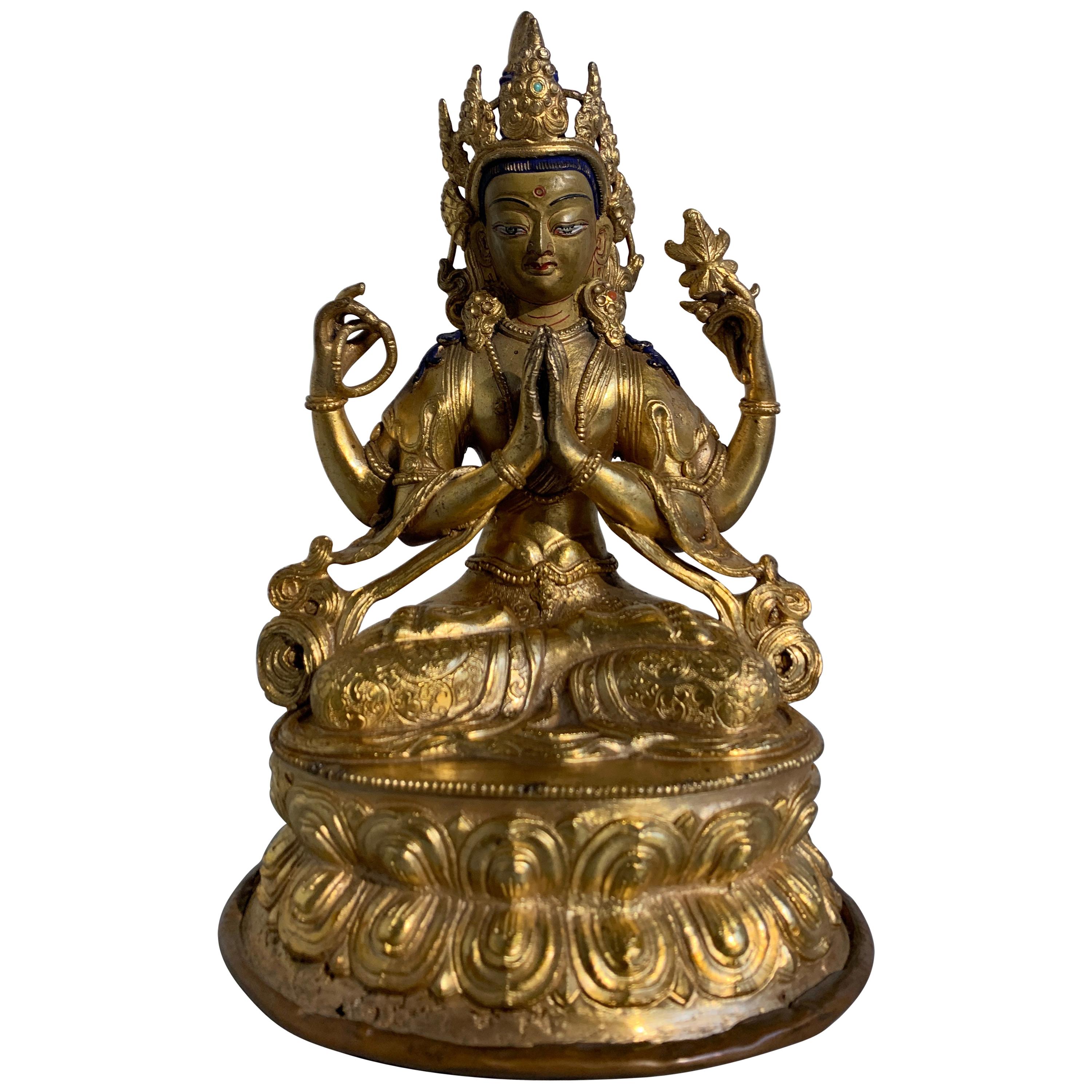Items Similar to 19th Century Vietnamese Carved and Gilt Seated Bodhisattva Holding a Flower
Want more images or videos?
Request additional images or videos from the seller
1 of 11
19th Century Vietnamese Carved and Gilt Seated Bodhisattva Holding a Flower
About the Item
Vietnamese 19th century carved, lacquered and gilt Bodhisattva holding a secret flower. The Bodhisattva is seated on a lotus, which represents the symbol of fortune. This symbol can be found throughout Buddhism. It features a mystical presence. Finely carved in wood, lacquered and covered with several shades of gold. A label on the bottom from a 19th century Paris shipper and handler.
In fine antique condition with age-appropriate patina and wear.
- Dimensions:Height: 21 in (53.34 cm)Width: 13.5 in (34.29 cm)Depth: 12 in (30.48 cm)
- Materials and Techniques:
- Place of Origin:
- Period:
- Date of Manufacture:circa 19th Century
- Condition:Wear consistent with age and use.
- Seller Location:New York, NY
- Reference Number:
About the Seller
4.9
Vetted Seller
These experienced sellers undergo a comprehensive evaluation by our team of in-house experts.
1stDibs seller since 2010
2,445 sales on 1stDibs
Typical response time: 2 hours
- ShippingRetrieving quote...Ships From: New York, NY
- Return PolicyThis item cannot be returned.
More From This SellerView All
- Japanese Edo Carved Wood Foo DogsLocated in New York, NYJapanese Edo period pair of foo dogs in delicately carved wood. The dogs have uniquely expressive faces, one with open mouth, the other with closed mouth ...Category
Antique 1750s Japanese Edo Sculptures and Carvings
MaterialsWood
- Japanese Momoyama Baku Figures in Carved Keyaki WoodLocated in New York, NYJapanese Momoyama period rare early pair of Baku figures, carved in keyaki wood with an exquisite wood grain, 17th century, circa 1650. The elephant-like Baku is an imaginary and co...Category
Antique 17th Century Japanese Sculptures and Carvings
MaterialsWood
- Japanese Momoyama Carved Wooden Shinto Temple Lion Dog FiguresLocated in New York, NYJapanese Momoyama period carved wooden Shinto temple entry figures in the form of royal lion dogs seated in traditional pose. The pieces have had some co...Category
Antique 17th Century Japanese Edo Sculptures and Carvings
MaterialsWood
- Japanese Okimono of a Shunga Lady Playing a BiwaLocated in New York, NYJapanese Heisei period wood carved okimono of a shunga lady playing a Biwa. Made during the Heisei period in circa 1990, the piece remains in remarkable vintage condition with age-ap...Category
1990s Japanese Modern Sculptures and Carvings
MaterialsWood
- Japanese Meiji Period Bronze Elephant Sculpture on Burlwood BaseLocated in New York, NYA Japanese Meiji period bronze elephant sculpture on its original burl-wood base. Old repair to the tail; some paint chips to bronze trunk; unsigned.Category
Antique 1880s Japanese Meiji Animal Sculptures
MaterialsBronze
- Japanese Meiji Bronze Sea-Hawk SculptureLocated in New York, NYA finely-cast large Japanese Meiji-period bronze sculpture of a sea-hawk with stretched-out wings, made in the 1880s. The eyes are gilded; both wings and the body of the hawk are det...Category
Antique 1880s Japanese Meiji Sculptures and Carvings
MaterialsBronze
You May Also Like
- Over Life-Size Tibetan Gilt Bronze Arm of a Bodhisattva, Late 19th CenturyLocated in Austin, TXAn impressive larger than life-size cast and gilt bronze left hand and arm of a bodhisattva, late 19th century or earlier, Tibet. The over-sized arm and hand of graceful proportions. The arm tapering down to a slender wrist embellished with a simple bracelet hiding the join between the hand and arm. The hand and arm richly gilt. The join to the elbow visible and exposed. The hand heavily cast, with nice detail to the fingernails and cuticles. The palm with simple incised lines. The hand, with the pointer and pinky fingers raised, and the middle and ring finger folded down touching the thumb, performs the gesture known as karana mudra, the gesture of dispelling evil. (Here in Texas we refer to this gesture as "Hook'em Horns!") Karana mudra is often associated with Avalokiteshvara, the bodhisattva of compassion, known in Tibet as Chenrezig, and in China as Guanyin. The hand and arm would originally have been part of a much larger sculpture. Unfortunately many Tibetan Buddhist sculptures...Category
Antique Late 19th Century Tibetan Tibetan Sculptures and Carvings
MaterialsBronze
- 19th Chinese Carved Hardwood Figure of an Immortal Holding a BatLocated in West Palm Beach, FL19th Chinese carved hardwood figure of an immortal holding a bat, well carved with inlaid bone eyes and teeth.Category
Antique Late 19th Century Chinese Chinese Export Sculptures and Carvings
MaterialsBone, Hardwood
- Chinese Ming Dynasty Lacquered and Gilt Bronze Bodhisattva, 17th CenturyLocated in Austin, TXChinese late Ming dynasty bronze figure of the Bodhisattva Avalokiteshvara, also known as Guanyin (Quan Yin, Kwan Yin, Kuan Yin), 17th century, China The figure well cast in two ...Category
Antique Mid-17th Century Chinese Ming Sculptures and Carvings
MaterialsBronze
- Burmese 19th Century Hand Carved, Gilded and Painted Sculpture of a Seated WomanLocated in Yonkers, NYA Burmese hand carved and gilded seated woman statue from the 19th century, in traditional costume. Created in Burma during the 19th century, this sculpture depicts a woman wearing a gilded traditional Burmese costume with sandals, and showcases black tied hair. Painted details enliven her face, which is accented by earrings. Carved details represent the folds of her clothes. Her perforate hands probably held something. Thanks to its very detailed aspect, this statue is an excellent example of the Burmese wood...Category
Antique 19th Century Burmese Sculptures and Carvings
MaterialsWood
- Small Song Dynasty Carved Wood Bodhisattva, 13th Century, ChinaLocated in Austin, TXA small and very fine Chinese carved sandalwood figure of a bodhisattva, possibly Avalokiteshvara (Guan Yin), Song Dynasty (960 to 1276), circa 13th ...Category
Antique 15th Century and Earlier Chinese Sculptures and Carvings
MaterialsHardwood
- Nepalese Gilt Bronze Figure of Bodhisattva Chenrezig, Mid-20th CenturyLocated in Austin, TXA nice vintage early to mid-20th century gilt bronze sculpture of the Buddhist deity Avalokiteshvara in his four armed form, known as Chaturbuhja, or Chenrezig in Tibet. Chenrezig, a form of Avalokiteshvara, the bodhisattva of compassion (known as Guan Yin or Kwan Yin in Chinese), sits in vajrasana upon a high double lotus pedestal. One pair of hands is clasped in prayer at heart level, the other pair of hands raised upwards at shoulder lever and holding discreet attributes, a mala (prayer beads) in one hand, a lotus blossom in the other. Chenrezig is dressed in an elaborately patterned floral dhoti that covers his lower half. His torso bare, shoulders covered with a shawl and scarves that billow out around him. He is festooned with jewels, necklaces, bracelets, armlets, earrings, belt and a five pointed crown. The earrings studded with coral. The crown studded with turquoise. His face is cold painted with beautiful details. The hair has been pigmented blue with crushed lapis, indicating his peaceful nature. The copper base plate is inscribed with a visvajra (double vajra...Category
Late 20th Century Nepalese Tibetan Sculptures and Carvings
MaterialsCoral, Lapis Lazuli, Bronze
Recently Viewed
View AllMore Ways To Browse
19th Century Flowers
19th Century Seat
19th Century Paris
Furniture With Carved Flowers
Wood Carved Flowers
19th Century Gilt Sculpture
Gilt Wood Carving
Gilted Wood Carving
Wood Carving Flowers
Gilt Lotus
Antique Gilt Wood Carvings
Lotus Flower Antique
Finely Carved Wood Sculpture
Asia Buddhism
Carved Lotus Flower
Antique Vietnam
Vietnam Antique
Antique Furniture Vietnam
